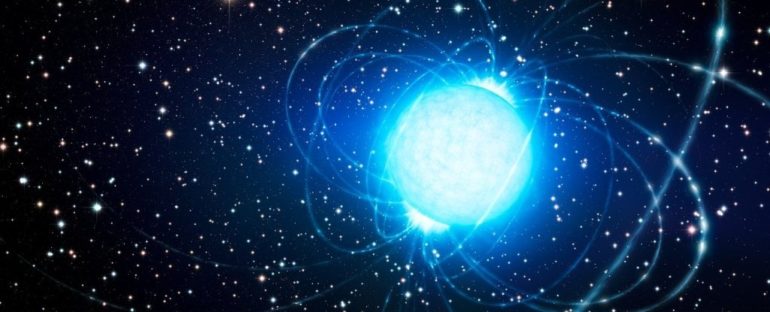An extremely magnetised star 16,700 light-years away could be the next clue in solving the mystery of fast radio bursts.
In data from observations of the magnetar 1E 1547.0-5408 taken in 2009, astronomers have just discovered a pair of bursts of radio emission that look incredibly similar to bursts from SGR 1935+2154 – a magnetar that, earlier this year, was finally identified as a source of fast radio bursts from inside our galaxy.
The emission from 1E 1547.0-5408 is a little outside the definition of fast radio bursts (FRBs) as we understand them from sources outside the Milky Way. But that, according to astronomer Gianluca Israel of the Astronomical Observatory of Rome in Italy, means that the definition may need to stretch a little.
“The new discoveries both on SGR 1935+2154 and 1E 1547.0-5408 have changed the FRB definition itself,” he told ScienceAlert.
“The emergent scenario is that of a continuum of radio burst properties and energies, filling the empty gap between giant pulses in ‘ordinary’ radio pulsars and FRBs.”
Fast radio bursts are a mystery that has challenged astronomers considerably. They’re mostly unpredictable, extremely powerful bursts of radio waves that last just milliseconds in duration. They can discharge as much energy as hundreds of millions of Suns, and most of the few dozen sources we’ve detected to date have only flared once.
This has made it nigh impossible to pin down what causes them, but in late April this year, we had an unexpected miracle: the magnetar SGR 1935+2154 spat out a burst that fit the profile perfectly – a radio spike milliseconds in duration and so powerful we could have detected it from another galaxy.
That event was officially confirmed as a fast radio burst, FRB 200428, earlier this month.
But SGR 1935+2154 wasn’t done. Since then it has emitted several more radio bursts – less powerful, but otherwise consistent with the fast radio burst profile.
Enter 1E 1547.0-5408. This magnetar is known for intermittent activity, during which it emits bursts of radiation in X-ray, gamma rays, and radio waves. It’s had at least three such outbursts, that we know of, in 2007, 2008 and 2009.
Since magnetars – neutron stars with insanely powerful magnetic fields – are relatively rare, astronomers recorded these outbursts avidly.
But fast radio bursts were only discovered in 2007; back then, no one was really looking for fast radio burst-like activity in magnetars.
“[Fast radio bursts] were being dismissed as artifacts of terrestrial origin like, for example, the effects of opening a microwave oven near the telescopes (some indeed were!), and ridiculed as ‘perytons‘,” Israel told ScienceAlert.
“While we believed that we were facing new, true astrophysical events, we were more into searching for similar events, so we were looking for extragalactic bursts.”
“On the pulsar side, we were focused on trying to understand the neutron star/magnetar magnetosphere, which is a mystery as complicated and fascinating as the FRB nature. In particular, at that time radio emission from magnetars was deemed an extremely rare phenomenon: associating it with FRBs would have appeared as a huge stretch of imagination.”
After the discovery of SGR 1935+2154, however, Israel and his colleagues decided to comb over data collected by the Parkes Observatory in Australia, NASA’s Chandra X-ray Observatory, and the ESA’s XMM-Newton, when 1E 1547.0-5408 was undergoing its brightest outburst in 2009.
Sure enough, on 3 February 2009, two bursts of radio waves were detected. The first was 200 milliseconds, with a fluence of 0.6 kiloJansky milliseconds, following about a second behind an X-ray burst. The second event was about the same length, and a little weaker.
Both peaks are wider and fainter than fast radio bursts, but the strength of the fainter bursts from SGR 1935+2154 is similar to the bursts from IE 1547.0-5408. Both magnetars have also displayed X-ray activity around the time of their radio bursts, as well as radio pulsations that were not aligned with the radio bursts.
This suggests there may be some variation in fast radio bursts; that, in turn, could help constrain the mechanisms that cause them, especially since both magnetars behave pretty much like normal magnetars otherwise. If so, it could help us figure out where extragalactic fast radio bursts are coming from.
“The phenomenology of radio bursts from magnetars is telling us that they could be responsible for at least a fraction of the FRBs observed so far in other galaxies,” Israel said.
“The paucity and sparseness of extremely bright radio bursts observed from magnetars in our galaxy (so far, only one) is also suggesting that not repeating FRBs (the majority of the sample) could be as well associated with magnetars: in this scenario, we have seen only one burst (so far) due to the intrinsic low occurrence rate of these events in magnetars.”
It’s unlikely that there are many other fast radio burst-like events hiding in old data. A frenzied search has occurred in the wake of SGR 1935+2154’s discovery, but so far not much has been turned up. The way forward, according to Israel, is to carefully monitor future magnetar outbursts.
This could help build a catalogue of radio bursts, ranging in strength and duration, to help fill out the continuum. And, even if the fainter, longer bursts are ultimately found to emerge from a different magnetar behaviour than the powerful bursts that can boom across millions of light-years, we still will know more than we did before.
“We believe that discoveries themselves are the most exciting part of our work. It is when during the analysis you realise there may be something new and interesting, and a plot pops up from your terminal confirming your suspicion,” Israel told ScienceAlert.
“All discoveries go in the same direction: they deepen our understanding of nature and the Universe.”
The research has been accepted into The Astrophysical Journal, and is available on arXiv.
